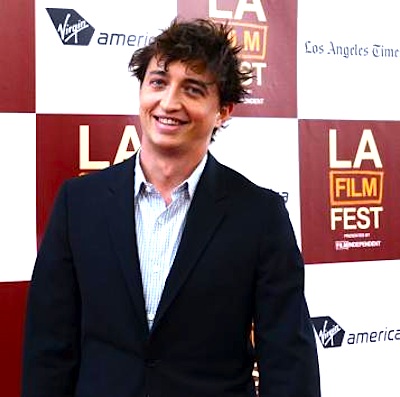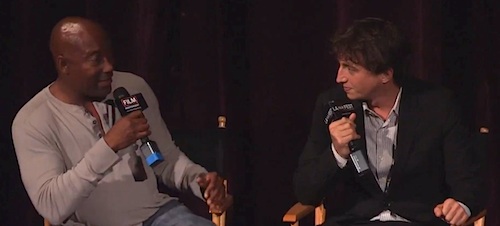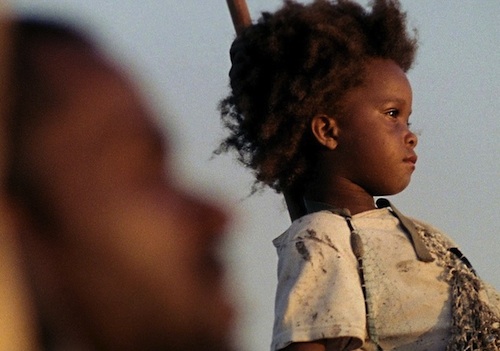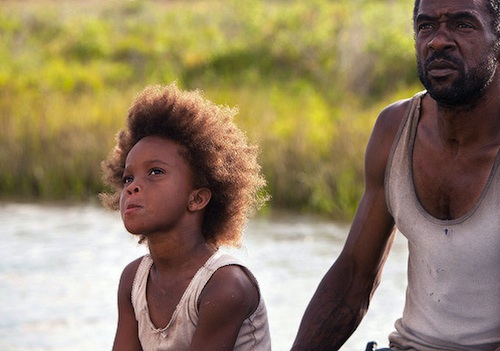By Govindini Murty. Benh Zeitlin’s Beasts of the Southern Wild has garnered much acclaim on the film festival circuit and is one of the top indie films in theatrical release right now, having already earned $5.9 million at the box office. The story of a little girl and her father struggling to survive in the flooded bayou of southern Louisiana, Beasts of the Southern Wild won the Grand Jury Prize at Sundance, the Camera D’Or at Cannes, and the Audience Favorite Award at the LA Film Festival. There is already talk that it may be nominated for an Oscar for Best Film, and that Quvenzhané Wallis, the film’s remarkable eight-year old lead, may be nominated for an Oscar for Best Actress.
We had the opportunity to attend the premiere of Beasts of the Southern Wild at the LA Film Festival this summer and enjoyed the Q & A conducted afterward by John Singleton with director Benh Zeitlin and the film’s stars, the irrepressible Quvenzhané Wallis (who utterly stole the show) and the charming baker-turned-actor Dwight Henry.
We spoke briefly with Benh Zeitlin after the screening and also met John Singleton, who expressed repeatedly what a fan he was of the film. Here’s the conversation I had with Zeitlin, followed by excerpts from the Q & A that Singleton held with Zeitlin, Wallis, and Henry. While there were a variety of topics discussed in the Q & A, my focus here is on the comments that Zeitlin made about the creative and practical aspects of translating his vision to the big screen.

GM: I was curious about your influences. Were you quoting anyone specific in the film? What inspired you – either in classic or contemporary film?
BZ: The big one for me is this film called Underground by Kusturica. That’s the one that made me most want to make films when I was growing up … the way that the fantasy and reality worked in that film I think was a big deal. And then we watched a lot of documentaries – we watched a lot of Les Blank documentaries. This one called Dry Wood – and all those ‘70s films that he made – were kind of how we came up with the cinematography. But you know, I studied the way that Cassavetes directs actors and Mike Leigh directs actors – and looking at narrative from Disney movies, like Bambi [Zeitlin himself has a background in animation and his parents are folklorists]. So, really, it was from all over the place, from all eras – from high-brow to low-brow – sort of a broad world.
GM: That’s interesting. You mention Les Blank – did you see Burden of Dreams, about Werner Herzog making Fitzcarraldo?
BZ: Oh yeah, of course. Werner Herzog, absolutely.
GM: Because [Beasts of the Southern Wild] just reminded me – the atmosphere – the organic feeling of being in the mud with the animals and the wilderness all around –
BZ: Definitely, yeah. He was a huge inspiration for me. The first time I saw that film I was like “This is what I want to do.”
GM: I interviewed Werner Herzog a few months ago and there’s some great footage from that film [Les Blank’s Burden of Dreams] that’s online. But you know, I was curious, because the film has that blend [of reality and fantasy] that you were mentioning. But I didn’t know about Bambi, that’s going to be interesting to throw in there –
BZ: [Laughs.] You got to go back to Bambi, always got to go back to Bambi.
GM: Well thanks so much, that was fun to see.
BZ: Thanks very much, nice to meet you.
Beasts of the Southern Wild tells the story of Hushpuppy (Quvenzhané Wallis), a six-year old girl growing up on an island off the coast of Louisiana known as “The Bathtub.” The story follows Hushpuppy and her widower father, Wink (Dwight Henry), as they eke out a living on their small plot of land – with the little girl caring for their farm animals and living in tune with the rhythms of the natural world. Her father, who has a mysterious illness, almost like a latter-day Fisher King, teaches Hushpuppy how to fish and emphasizes that she needs to learn how to take care of herself so she can succeed in the world and climb to the “top of the ladder.”
The island community of the Bathtub might lie in the shadow of New Orleans and Lake Pontchartrain, but its rural lifestyle feels a world away. To emphasize this, Beasts was shot in a documentary-verité style on 16mm film, which, when blown up on a large screen, creates a grainy, mysterious image that paradoxically heightens the mythological and poetic themes of the film. Hushpuppy’s view of the world is thus depicted in an alternately realistic and fantastical manner that Benh Zeitlin called “a heightened world built out of very real parts.” For example, Zeitlin noted that though there is no place called the Bathtub in Louisiana, it was based on the real Isle de Jean Charles, an island that is slowly falling into the Gulf and that has gone from 200 families to 20 families in recent years. As Zeitlin explains, “we took elements of things and swirled them together – almost like a folk tale.”
In her acting debut, Quvanzhané Wallis brings a remarkable intensity and intelligence to the role of Hushpuppy. Like many precocious children, Hushpuppy possesses a mystical and over-determined sense of herself. She worries that mischievous or rebellious things that she’s done will cause the universe to change and the glaciers to melt. As depicted in her fantastical visions, Hushpuppy imagines that her actions will bring primeval life forces (represented by prehistoric beasts known as aurochs) down to overwhelm her little plot of land. These animals are symbolic of the larger forces of adulthood and responsibility that will crash down on Hushpuppy as her father proves increasingly unable to care for her. Ultimately, when a massive storm hits the small community of the Bathtub (a storm implied to be Hurricane Katrina), it is a confirmation of her own inner turmoil. Nonetheless, it is the chaos and destructiveness of the storm that gives Hushpuppy a chance to demonstrate her will to live and to rebuild.
Here are some highlights from the Q & conducted by John Singleton with Benh Zeitlin, Quvenzhané Wallis, and Dwight Henry.
JS: How does a movie like this evolve … how does a film like this rise out of the bayou, and in such an organic fashion?
BZ: It sort of started with an idea to make a film about a kind of last stand, about the hold outs holding on to their place. I remember I started driving down to the end of every road, and these by-roads going down to the marsh. I basically got to the very end of the road and I saw that horse that we photographed in the film standing on that island on the other side of the water, kind of cut off from the land. I remembered seeing that horse – and that was the last stand, that was what the film was about. That idea combined itself with this play called Juicy and Delicious by Lucy Alibar about a father and daughter. And it was kind of a connection that happened in my mind between a community losing their land and a little girl losing her dad. Lucy and I got together and co-wrote the script together and that was how the project came about. ….
JS: The evolution of this film – from conception to writing the script. How much input and leeway did you give to your actors – and the environment – to actually put this thing together in an organic fashion? How much influence was the environment and the different elements in this film?

BZ: When we were writing the script we were trying to location scout and cast and do all those things while we were writing the script, so the script was constantly evolving based on the elements that were coming into it. You know, a big part of the idea is that this film was very intensely collaborative and the final characters you see in the film were really a combination of what me and Lucy wrote and what these guys and the rest of the cast brought to the film.
Before we would even start rehearsal, a good example is: me and Dwight would sit in the bakery from midnight until six in the morning – while he’s making donuts (chuckles from audience) – and go through his whole life, my whole life – and then take scenes from the film, and attach them to moments from his own life. And we’d talk about – you know, he has a daughter and is a father, and I’m not, so certain moments we may have written a certain way [and] he would give us a new perspective on [how] that would change the action in the film. […] A lot of times we would read the script a couple of times and we would take it away and say, you know, “Dwight – how would you say this?” and “This is the point of the scene – how would you express this?” and you know, that happened with every actor. Quvenzhané would sit with me at the computer and delete words and add in her own.
And so it became a very intense collaboration, where the final voice in the film was as much a credit to these guys and other actors in the film. And the same thing with the place – you just sort of want to let these elements breath and not want to squash them with your kind of preconceptions about what it should be.
JS: The opening sequence is phenomenal – the whole sort of coming into the environment of the Bathtub in a sort of celebratory way. My first observation of it is on the professionalism. The interesting thing is that you shoot it in a way that’s kind of documentary verité, at the same time it’s a fantasy. […] The movie, it has an interesting effect on the viewer; it feels basically like reality but then it’s also a fantasy, as well. So, the psychological effect is very unusual. Can you talk about that – elaborate on that? Because I was thinking – when I first saw it, like three-quarters in: “Wow, like, Fellini would love this movie.” But that would be over-intellectualizing it. I think the movie came out as a very organic thing. Why don’t you talk a little about what you were thinking thematically as you were shooting it – and how you handled the post on this as well.

BZ: Yeah, it’s sort of a heightened world but it’s all built out of very real parts, and that’s kind of on every level. You know, the culture of the Bathtub is something that is taken from – you know that place doesn’t exist in the world, and there’s nothing specifically like that. The culture’s kind of taken from New Orleans and South Louisiana and West Louisiana, and it’s a collage of things that all exist in the region. And then you know, at the same time, all the things that are in the film are built by hand and really exist.
JS: There’s no real place like the Bathtub.
BZ: I mean, there is actually, there is a town called Isle de Jean Charles and you see in the shot in the film [that] it’s at the end of the three mile road, there’s this island that’s falling off into the Gulf that’s gone from 200 down to 20 families in the past forty years. But if you go to Isle de Jean Charles it’s not like that. We took elements of things and swirled them together and try to find something that’s almost like a folktale; it felt a little more raw, like a specific place.
And then we tried to create everything, actually experience everything, so when you see those parades … we set up the parade and we knew where the shots were and we had it all planned, but you throw enough chaotic elements on screen together with children and animals and boats and then at a certain point your plans don’t work out and you just have to chase [the movie] – the same way a documentarian would chase the scene. Our cinematographer, he was just running after the movie at a certain point. And that was something that we wanted – we wanted to create sets where everyone would inhabit the world …
JS: How do you go from that, from it being a very reality-based thing, to having an adjustment to reality and fantasy? That’s where the power of the movie is. The movie is kind of a trip.

JS: I want to talk about the production design of the picture, because it’s such a huge part of the organic [aspect] of it. The homes that were made, and the town, the production of the town – could you talk a bit about that?
BZ: Yeah, it was a lot of: we’d find an amazing place, and we’d sort of build on top of it a lot of the time. So about half of what you see is actually there and half of it we created. The big challenge of the production design was how we were going to create the end of the world. [This was] inspired by, as you drive down these roads you sort of see – the way the environment is dying as you get closer and closer to the Gulf. So basically the idea was we were going to have a town that we’d move three times. So we basically built on top of this one place that was very lush, and then we would dismantle all the stuff that we’d added and go out into this flooded area, and build those same sets flooded, and then we’d take those same sets and take them to Isle de Jean Charles for our final end as the location. We weren’t actually able to build the town on the budget we had, it was a matter of finding these places that matched and trying to add on top of them with all kind of organic pieces and make it all feel like it was a coherent place in those locations. …
Beasts of the Southern Wild, a Fox Searchlight release, is currently screening in theaters nationwide.
Posted on August 8th, 2012 at 8:40pm.